Introduction by St. Paul Street Evangelization
In September of 2020, St. Paul Street Evangelization published an essay concerning allegedly “false” Miraculous Medals said to be in circulation.[1] Another claim has arisen that states there are “false” medals of St. Benedict in circulation.[2] Similar to the claims of “false” Miraculous Medals, it is alleged that there is a Freemasonic conspiracy that puts Masonic elements into the St. Benedict medal. After a review of the claim and the source(s) behind it, St. Paul Street Evangelization would like to issue the following information.
As it is presented, the claim that there are false St. Benedict medals in circulation appears to be dubious, spurious, and based upon ignorance of the historical facts. An older version of a St. Benedict medal was in circulation for many years. The famous Abbot of Solemnes, Dom Prosper Guéranger, wrote an essay about it that was published in 1862. Eighteen years later (1880), there was a commemoration of the 1400th anniversary of the birth of St. Benedict (480). A desire to strike a new medal arose on the occasion of this anniversary, and was approved by Pope Bl. Pius IX in 1877. It became known as the “Jubilee Medal,” and its design is the one most people are familiar with today. The new medal was overseen by the monks of Beuron (Germany).
The website Traditions-Monastiques, an apostolate of the Abbey of St. Joseph of Clairval (France), published a very helpful article in French that covers important aspects of the history and development of the St. Benedict medal.[3] St. Paul Street Evangelization has translated this document into English and provides it here for the edification of the reader. We believe that it addresses satisfactorily the claim of allegedly “false” St. Benedict medals in circulation.
St. Paul Street Evangelization
October 2, 2023 A.D.
The Feast of the Holy Guardian Angels
Nota Bene: St. Paul Street Evangelization makes no copyright claim either to the French text from Traditions Monastiques, or the English translation. No monies are made by this translation, and it is published with permission from Traditions Monastiques. This permission does not imply that Traditions Monastiques endorses our apostolate.
For a free PDF copy of this article, please click here.
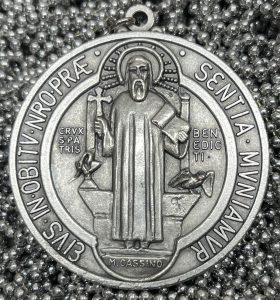 True and false medals of St. Benedict
True and false medals of St. Benedict
When we learn about the history of the St. Benedict medal, by going through blog articles devoted to this medal or visiting different religious shops that sell it, one can, on the one hand, be surprised or even disturbed to note that there are important differences between the medals of St. Benedict, and, on the other hand, be baffled by the arguments which explain that only such or such a St. Benedict medal is authentic. What should we think of all this?
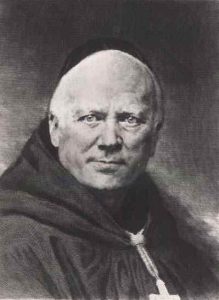
Dom Prosper Guéranger Image by: Claude Ferdinand Gaillard, Public domain, via Wikimedia Commons
Dom Guéranger and the cross of St. Benedict
Regarding the medal of St. Benedict, the work which makes reference is the book of Dom Guéranger, founding abbot of the abbey of Saint Peter of Solesmes, “Essay on the origin, the meaning and privileges of the medal or cross of Saint Benedict.” Edited in 1862, this essay keeps all its topicality and all the later works on the medal of St. Benedict are largely based on this publication.
At the beginning of his essay, Dom Guéranger described the medal of St. Benedict as it was in his time and which he reproduced at the beginning of his work.

Original Image of the St. Benedict medal known to Guéranger (from the 1862 French edition of his Essay)
Front of the medal known by Dom Guéranger
The front of the medal has a cross with a whole series of characters which are found identically on all the medals of St. Benedict; it is therefore not necessary to stop at length except on the IHS monogram. We will talk about it later.
The portrait of St. Benedict on the back

St. Benedict is represented with a cross in his hand. This alludes to different episodes of his life told by his biographer St. Gregory the Great. This disciple of St. Benedict tells how the patriarch of the monks of the West repelled the temptations, attacks and vexations of the Devil by the simple sign of the cross.
The face of St. Benedict is unknown to us, therefore, when we represent it in an image, we add attributes so that it can be identified without hesitation. Thus, on the medal of St. Benedict that Dom Guéranger took up at the beginning of his work, several attributes were represented, in addition to the cross in the hand:
- monastic cowl [cuculla],
- the rule book in hand,
- a miter on the foot,
- a crow.
Identification of the portrait of St. Benedict
Taken separately, these attributes are not sufficient to identify the person of St. Benedict in a certain way, except perhaps the Rule. But taken together, the identification of St. Benedict becomes certain:
– the cross recalls his victories over the demon,

– the miter indicates that he is abbot, the patriarch of the monks of the West,
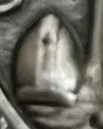
– the book in the hand symbolizes the monastic Rule he wrote,
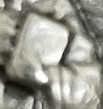
– the crow recalls an episode in his life where this bird carried out a mission requested by St. Benedict: to throw poisoned bread where no one can find it.
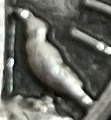
Different portraits of St. Benedict?
In his book, Dom Prosper Guéranger emphasizes the importance of the representation of St. Benedict and objects to certain alterations, which do not lose the title of “medal of St. Benedict” but are a serious impropriety. He rightly recalls the maintenance of the attributes that the ecclesiastical tradition assigned to each saint under pain of irreverence. But he does not say, as some people want us to believe, that all these attributes are necessary for the true medal or cross of St. Benedict.
Essential elements of the St. Benedict Medal
We can therefore wonder: what are the essential elements for a medal of St. Benedict to be authentic?
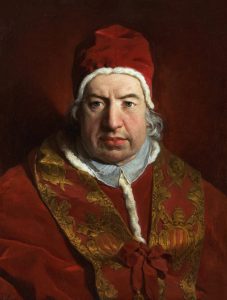
Pope Benedict XIV (r. 1740-1758) Pierre Subleyras, Public domain, via Wikimedia Commons
In the problem at hand, our work is well facilitated by the brief of [Pope] Benedict XIV in which is described what is the medal or cross of St. Benedict. As it is a document of the Supreme Pastor, his authority cannot be questioned. Here is the way he describes the St. Benedict medal:
“…Medals known as the Cross of St. Benedict, and one side of which represents the image of St. Benedict, and the other a Cross with these letters or characters at its circumference meaning respectively the following: …” (then comes the whole series of letters found on all medals).
The Roman Pontiff simply speaks of an image without specifying any attribute. This gives a certain freedom. It is therefore sufficient that the representation is such that it leaves no doubt about the identity of the person engraved on the medal. It is not necessary to focus on this or that detail, but to see the whole. When we look at the different models of medals of St. Benedict, we notice that they have an inscription either on the perimeter “S. Benedicti Monachorum Patriarch,” either on either side of the silhouette of St. Benedict “Crux S. P. Benedicti.” Such an inscription is sufficient to remove any doubt about the identity of the character. This inscription refers us to the iconographic tradition of the Eastern Churches according to which an icon of a saint is completed by the inscription of the name of the saint. From there, it appears that for the authenticity of a medal of St. Benedict in terms of the image of the saint, it suffices to represent the face of a monk with one or more attributes specific to St. Benedict and to engrave the name of the Holy Patriarch. In this way, no doubt is possible about the identity of the person represented.
The PAX or IHS inscription of the medal
Reading carefully the brief of Benedict XIV, there is no mention of this inscription when he could very well have spoken of it when he carefully describes the front of the medal of St. Benedict with all the series of letters. We are therefore entitled to conclude that IHS is not a fundamental element of the St. Benedict medal.

Furthermore, it is quite possible that on the first medals, IHS was not present since it comes from St. Bernardin of Siena in the 15th century and the Jesuits who frequently used this monogram of the name of Jesus in the decoration and for the promotion of the Catholic counter-reform.
On the other hand, by recalling the origin of the PAX, it will become clearer that the IHS is not compulsory.
The Jubilee Medal
In 1880, the Order of St. Benedict was preparing to celebrate the 1400th anniversary of the birth of the Holy Patriarch of the monks of the West. For this occasion, the Abbey of Beuron struck a new medal of St. Benedict, known as the Jubilee Medal. Instead of IHS, it includes the Benedictine PAX motto. This medal was approved by Pope Pius IX in 1877. With such approval, is it not to recognize that this medal is an authentic medal of St. Benedict? Is this not implicitly recognizing that the IHS is not an essential element of the cross of St. Benedict?

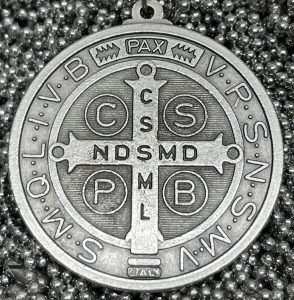
Since then, this model has become the most widespread. Many medals of St. Benedict sold on our religious shop use this model: [Traditions Monastiques Store/St. Paul Street Evangelization Store]
Some medals have both PAX and IHS (enough to satisfy everyone).
From all of this, we can conclude that the concept of authenticity should not be understood in too narrow or too material a way. Based on official documents, the brief of Benedict XIV, it is easy to recognize that the supreme authority leaves certain latitudes. Pope Pius IX, approving the Jubilee Medal, confirms this interpretation. We cannot simply rely on the authority of Dom Guéranger to discern the real medals of St. Benedict from the false as do certain articles that we can read on the Internet.
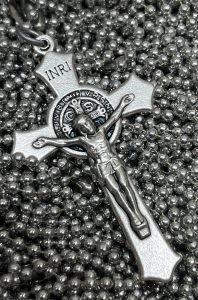
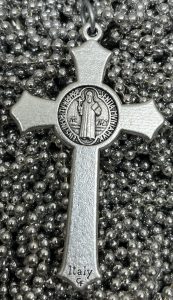
St. Paul Street Evangelization
26238 Ryan Road
Warren, MI 48091
(657) 777-2963
info@stpaulev.com
Traditions Monastiques
Abbaye saint Joseph de Clairval
6 Grande Rue
Traditions Monastiques
21150 Flavigny sur Ozerain
FRANCE
contact@traditions-monastiques.com
Tél. : 03 80 96 22 31
Notes:
[1] “Concerning the Miraculous Medal: Examining an Objection.” St. Paul Street Evangelization (September, 2020).
[2] “The Medallion of Saint Benedict – true and false.” sanctamissa.pl (Date unknown); “Saint Benedict Medal.” sanctamatermaria.com (Date unknown).
[3] “Vraies et fausses médailles de saint Benoît.” Traditions-Monastique (December 20, 2018).